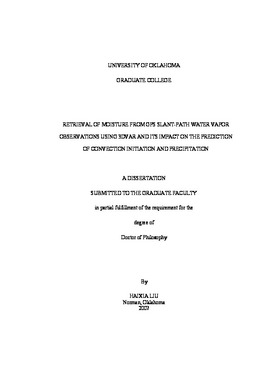| dc.contributor.advisor | Xue, Ming, | en_US |
| dc.contributor.author | Liu, Haixia. | en_US |
| dc.date.accessioned | 2013-08-16T12:20:38Z | |
| dc.date.available | 2013-08-16T12:20:38Z | |
| dc.date.issued | 2007 | en_US |
| dc.identifier.uri | https://hdl.handle.net/11244/1181 | |
| dc.description.abstract | The anisotropic explicit filter is computationally expensive in both CPU time and memory usage. Therefore the implicit recursive filter which is computationally much more efficient is implemented in our 3DVAR system, even though its implementation is significantly more complicated. A similar set of water vapor analysis experiments using the recursive filters is performed. The analyses thus obtained are generally comparable to or better than those obtained using the corresponding explicit filters. In addition, the sensitivity of the analyses to the spatial de-correlation scales of the background error is systematically examined. | en_US |
| dc.description.abstract | A set of high-resolution numerical experiments is conducted using the Advanced Regional Prediction System (ARPS) for a case that occurred on 12 June, 2002 and involved multiple initiations of convection. The results are verified against the radar composite reflectivity in detail. It is shown that the model performs reasonably well on predicting the initiation timing and location and the subsequent storm evolution for up to 7 hours. Using the most realistic simulation of this case as the 'truth', simulated SWV data and surface moisture observations are generated to perform a set of Observing System Simulation Experiments (OSSEs) using our 3DVAR system with recursive filters. The preliminary results illustrate that convection initiation (CI) without strong low-level mesoscale forcing is highly sensitive to the moisture initial condition and the use of SWV and surface data improves the moisture analysis and thus the prediction of CI and precipitation. The enhanced moisture analysis obtained from the use of anisotropic background error further improves the precipitation forecast though it does not lead to positive impact on the prediction of exact timing and location of the CI due to its high sensitivity to very small-scale moisture structures. | en_US |
| dc.description.abstract | The 3DVAR system developed in this study is based on a terrain-following coordinate. A non-negative water vapor weak constraint is included in the cost function. The background term and its associated background error covariance are considered in the system and the latter is modeled using explicit or implicit recursive spatial filters. Most importantly, a direct way to estimate a flow-dependent background error covariance based on the idea of Riishojgaard is proposed for the moisture analysis. The explicit spatial filter first is implemented with both isotropic and anisotropic options. It is demonstrated that this system is robust on deriving mesoscale moisture structures from the GPS SWV and surface observations and the analysis is improved when the anisotropic background error covariance is used. Sensitivity experiments show that surface moisture data are important for the analysis near ground and a vertical filter is essential to obtain an accurate analysis near the surface. The positive impact of flow-dependent background error is enhanced when the density of GPS receiver network is lower. | en_US |
| dc.description.abstract | The accurate prediction of convection initiation and the subsequent precipitation in a cloud-resolving numerical model is highly dependent on the precise estimate of the three-dimensional moisture in the initial condition because water vapor is directly involved in the formation of clouds and precipitation. However, the water vapor is currently poorly characterized due to its high variability in space and time. A three-dimensional variational analysis system (3DVAR) is developed in this dissertation to retrieve the moisture field from simulated ground-based GPS slant-path integrated water vapor (SWV) data that are potentially available at high temporal and spatial resolutions. | en_US |
| dc.format.extent | xvii, 188 leaves : | en_US |
| dc.subject | Precipitation forecasting. | en_US |
| dc.subject | Geotechnology. | en_US |
| dc.subject | Atmospheric Sciences. | en_US |
| dc.subject | Precipitable water. | en_US |
| dc.subject | Water vapor, Atmospheric. | en_US |
| dc.title | Retrieval of moisture from GPS slant-path water vapor observations using 3DVAR and its impact on the prediction of convection initiation and precipitation. | en_US |
| dc.type | Thesis | en_US |
| dc.thesis.degree | Ph.D. | en_US |
| dc.thesis.degreeDiscipline | School of Meteorology | en_US |
| dc.note | Adviser: Ming Xue. | en_US |
| dc.note | Source: Dissertation Abstracts International, Volume: 68-04, Section: B, page: 2173. | en_US |
| ou.identifier | (UMI)AAI3261104 | en_US |
| ou.group | College of Atmospheric & Geographic Sciences::School of Meteorology | |
